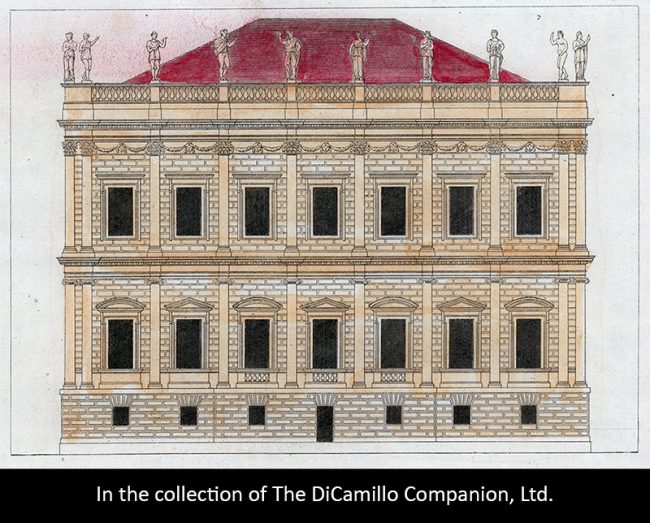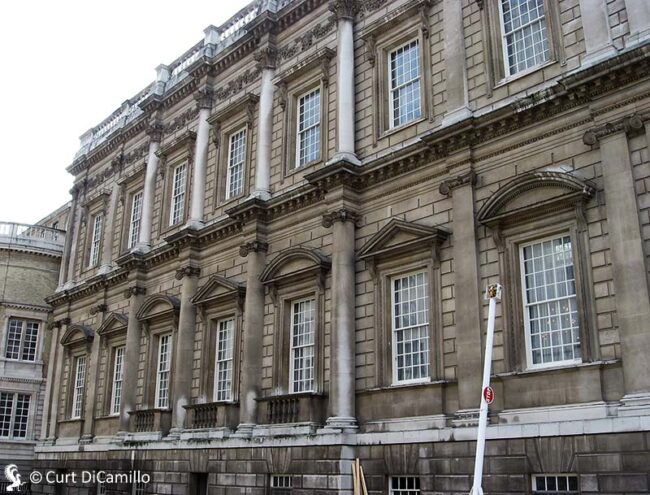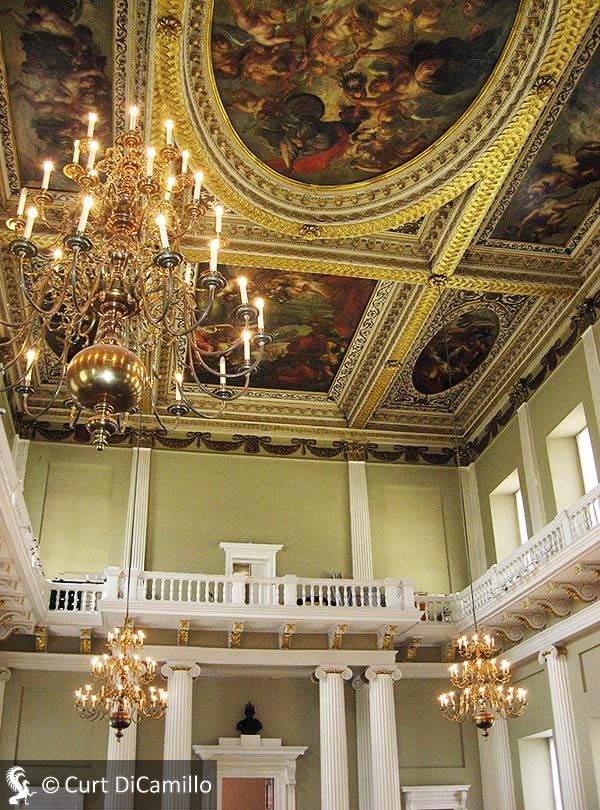
The palace, as seen in the late 17th century, from a circa 1850 engraving.

The exterior of the Banqueting House from a hand-colored engraving from "L'Univers Pittoresque," Paris, 1847.

The exterior of the Banqueting House in 2010

The interior of the Banqueting House

The interior of the Banqueting House

The throne in the Banqueting House

Vermeil sconce, one of a set of six made for James II's council chamber at Whitehall Palace. Made in 1686 by Robert Smythier and today in the collection of the Fitzwilliam Museum, Cambridge.
House & Family History: By the 13th century the Palace of Westminster had become both the center of government in England and the primary London residence of the monarch. In 1534 Henry VIII acquired the nearby York Place from Cardinal Thomas Wolsey and renamed it the Palace of Whitehall, its name derived from the white stone used to build it. Thus, the Palace of Whitehall was incorporated into the complex collectively called the Palace of Westminster—a collection of buildings that housed the Royal Law Courts, the Houses of Parliament, the king, the offices of the Royal Household, and other government offices. By the 17th century the Palace of Whitehall had grown into a higgledy–piggledy collection of buildings of different architectural styles—a complex in its own right. It looked more like a small town than a single building. By 1650 the palace was the largest complex of secular buildings in England; by 1690 it had grown to over 1,500 rooms, making it the largest palace in Europe, bigger even than Versailles! A great fire on January 4, 1698 destroyed most of the palace. John Evelyn wrote of the fire the next day in his diary: "Whitehall burnt! Nothing but walls and ruins left." After the fire burned itself out, only the Banqueting House and some miscellaneous buildings were left intact (some in Scotland Yard and others facing the park). During the 18th century the Crown Estate leased the land on which the palace had stood for the construction of townhouses. James I’s 1622 Banqueting House is the only above-ground building that remains today from the Palace. The Banqueting House is famous for its compartmented ceiling that frames Sir Peter Paul Rubens’s 1635 “Apotheosis of James I,” ironically commissioned by Charles I, who was executed in front of the building in 1649. The Palace of Whitehall was witness to other important royal happenings. Henry VIII married two of his wives here—Anne Boleyn in 1533 and Jane Seymour in 1536. Henry died at the palace in January of 1547, as did Charles II in February 1685. On a happier note, the palace hosted the first known performance of Shakespeare's “The Tempest” in 1611. Whitehall Palace remained the London residence of the monarch until 1698. Today’s 19th century Houses of Parliament, and the medieval Westminster Hall (built in 1097 and once the largest hall in Europe), are collectively and formally called the Palace of Westminster, a remnant and reminder of the great royal and governmental complex that once existed here.
Collections: The fire of January 4, 1698 destroyed many works of art in the Royal Collection, including Hans Holbein the Younger's mural portrait of Henry VIII, Gian Lorenzo Bernini's marble bust of Charles I, and Michelangelo's Cupid, a sculpture purchased by Charles I as part of the Gonzaga Collection. This magnificent collection deserves a few words. Formed in Mantua by the dukes of Gonzaga over a period of 150 years, the collection was one of the largest in Europe. It contained over 2,000 paintings and more than 20,000 ceramics, books, manuscripts, bronzes, statuary, coins, medals, and arms. The best of the paintings (and some marbles) were sold to Charles I between 1627 and 1630. Sadly, most of paintings were dispersed after the execution of Charles and the establishment of the Commonwealth; one of the few pieces that Cromwell saved was "The Triumphs of Caesar," a series of nine large paintings created by Andrea Mantegna between 1484 and 1492, today in the collection of Hampton Court Palace. The pieces of the Gonzaga Collection that Charles did not purchase were lost or scattered when the Ducal Palace in Mantua was sacked in 1629-30 by troops of the Holy Roman Emperor Ferdinand II as part of War of the Mantuan Succession, a peripheral part of the Thirty Years' War. One of a set of six vermeil sconces made by Robert Smythier in 1686 for the council chamber at Whitehall Palace is today in the collection of the Fitzwilliam Museum, Cambridge (see "Images" section).
Chapel & Church: A number of marble carvings from the chapel built for James II are today in St. Andrew's Church, Burnham-on-Sea, Somerset. In 1820 the carvings were moved from Westminster Abbey, where they had been since 1706, to the Somerset church.
Architect: Christopher Wren
Date: 1687-88House Listed: Grade I
Park Listed: No Park
Past Seat / Home of: King Henry VIII, 16th century.
Current Ownership Type: Historic Royal Palaces
Primary Current Ownership Use: Visitor Attraction
House Open to Public: Yes
Phone: 02031-666-000
Email: [email protected]
Website: https://www.hrp.org.uk/
Historic Houses Member: No